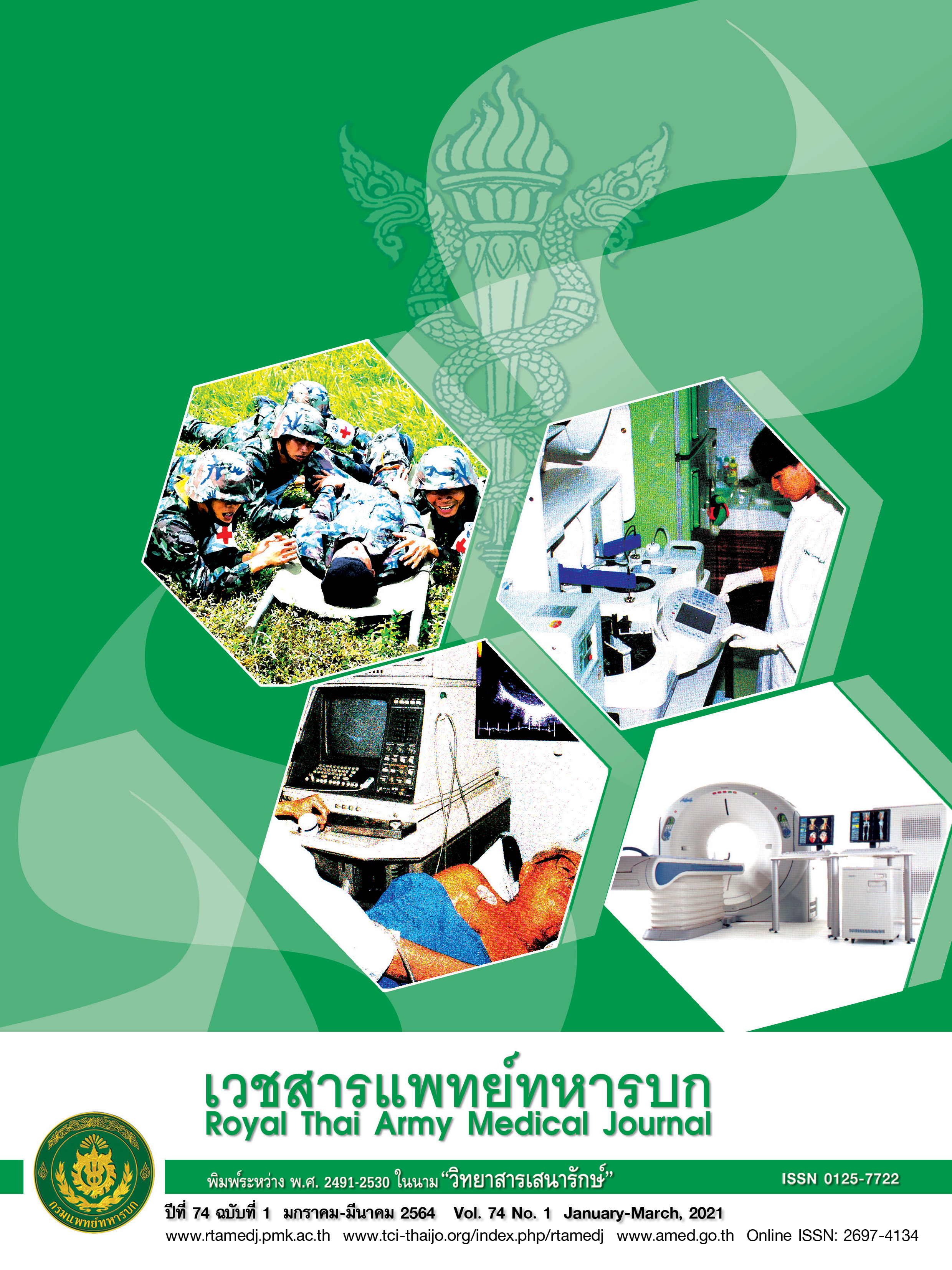ผลทันทีของการเคลื่อนไหวลำตัวส่วนล่างและการจินตนาการการเคลื่อนไหวลำตัวส่วนล่างต่อการทรงตัวและการรับรู้ตำแหน่งของลำตัวในผู้ใหญ่ที่มีสุขภาพดี
Main Article Content
บทคัดย่อ
วัตถุประสงค์ ศึกษาผลทันทีของการฝึกการเคลื่อนไหวลำตัวส่วนล่างและการจินตนาการการเคลื่อนไหวลำตัวส่วนล่างต่อการทรงตัวและการรับรู้ตำแหน่งของลำตัวในผู้ใหญ่ตอนต้นที่มีสุขภาพดี วัสดุและวิธีการ อาสาสมัครจำนวน 42 คน แบ่งเป็น 3 กลุ่มๆ ละ 14 คน คือ กลุ่มฝึกการเคลื่อนไหวลำตัวส่วนล่าง (LTE; n = 14) กลุ่มฝึกจินตนาการการเคลื่อนไหวลำตัวส่วนล่าง (ILTE; n = 14) และกลุ่มฝึกการเคลื่อนไหวลำตัวส่วนล่างร่วมกับการจินตนาการการเคลื่อนไหวลำตัวส่วนล่าง (LTE + ILTE; n = 14) เป็นเวลา 15 นาที อาสาสมัครถูกทดสอบความสามารถในการทรงตัวให้อยู่ในศูนย์กลางขณะที่มีและไม่มีข้อมูลป้อนกลับ และการรักษาจุดศูนย์กลางให้อยู่ในกรอบรูปร่างที่กำหนดในช่วงก่อนการฝึก และหลังการฝึกทันที ผลการศึกษา ไม่พบความแตกต่างของความสามารถในการทรงตัวให้อยู่ในศูนย์กลางขณะที่มีและไม่มีข้อมูลป้อนกลับ และการรักษาจุดศูนย์กลางให้อยู่ในกรอบรูปร่างที่กำหนดภายหลังการฝึกทั้ง 3 กลุ่ม และระหว่างกลุ่ม (p > 0.05) ยกเว้นความสามารถในการทรงตัวให้อยู่ในศูนย์กลางขณะที่ไม่มีข้อมูลป้อนกลับในกลุ่ม ILTE มีค่าน้อยกว่ากลุ่ม LTE (p < 0.05) สรุป โปรแกรมการฝึกการเคลื่อนไหวลำตัวส่วนล่าง การจินตนาการการเคลื่อนไหวลำตัวส่วนล่าง และการฝึกทั้งสองแบบร่วมกันในผู้ใหญ่ตอนต้น ส่งผลต่อความสามารถในการทรงตัวขณะอยู่นิ่ง และการทรงตัวขณะเคลื่อนที่ไม่แตกต่างกัน
Downloads
Article Details
บทความในวารสารนี้อยู่ภายใต้ลิขสิทธิ์ของ กรมแพทย์ทหารบก และเผยแพร่ภายใต้สัญญาอนุญาต Creative Commons Attribution-NonCommercial-NoDerivatives 4.0 International (CC BY-NC-ND 4.0)
ท่านสามารถอ่านและใช้งานเพื่อวัตถุประสงค์ทางการศึกษา และทางวิชาการ เช่น การสอน การวิจัย หรือการอ้างอิง โดยต้องให้เครดิตอย่างเหมาะสมแก่ผู้เขียนและวารสาร
ห้ามใช้หรือแก้ไขบทความโดยไม่ได้รับอนุญาต
ข้อความที่ปรากฏในบทความเป็นความคิดเห็นของผู้เขียนเท่านั้น
ผู้เขียนเป็นผู้รับผิดชอบต่อเนื้อหาและความถูกต้องของบทความของตนอย่างเต็มที่
การนำบทความไปเผยแพร่ซ้ำในรูปแบบสาธารณะอื่นใด ต้องได้รับอนุญาตจากวารสาร
เอกสารอ้างอิง
2. Winter DA. Sagittal plane balance and posture in human walking. IEEE Eng Med Biol Mag. 1987;6(3):8-11.
3. Simoneau M, Guillaud E, Blouin J. Effects of underestimating the kinematics of trunk rotation on simultaneous reaching movements: predictions of a biomechanical model. J Neuroeng Rehabil. 2013;10(1):54.
4. Cabanas-Valdés R, Bagur-Calafat C, Girabent-Farré M, Caballero-Gómez FM, Hernández-Valiño M, Cuchí GU. The effect of additional core stability exercises on improving dynamic sitting balance and trunk control for subacute stroke patients: a randomized controlled trial. Clin Rehabil. 2016;30(10):1024-33.
5. Skoura X, Papaxanthis C, Vinter A, Pozzo T. Mentally represented motor actions in normal aging. I. Age effects on the temporal features of overt and covert execution of actions. Behav Brain Res. 2005;165(2):229-39.
6. Sirigu A, Duhamel JR, Cohen L, Pillon B, Dubois B, Agid Y. The mental representation of hand movements after parietal cortex damage. 1996;273(5281):1564-8.
7. Papaxanthis C, Schieppati M, Gentili R, Pozzo T. Imagined and actual arm movements have similar durations when performed under different conditions of direction and mass. Exp Brain Res. 2002;143(4):447-52.
8. Cerritelli B, Maruff P, Wilson P, Currie J. The effect of an external load on the force and timing components of mentally represented actions. Behav Brain Res. 2000;108(1):91-6.
9. Sidaway B, Trzaska AR. Can mental practice increase ankle dorsiflexor toque?. Phys Ther. 2005;85(10):1053-60.
10. Gentili R, Papaxanthis C, Pozzo T. Improvement and generalization of arm motor performance through motor imagery practice. Neuroscience. 2006;137(3):761-72.
11. Williams JG, Odley JL, Callaghan M. Motor imagery boosts proprioceptive neuromuscular facilitation in the attainment and retention of range-of -motion at the hip joint. J Sports Sci Med. 2004;3(3):160-6.
12. Fansler CL, Poff CL, Shepard KF. Effects of mental practice on balance in elderly women. Phys Ther. 1985;65(9):1332-8.
13. Bae YH, Ko YJ, Ha HG, Ahn SY, Lee WH, Lee SM. An efficacy study on improving balance and gait in subacute stroke patients by balance training with additional motor imagery: a pilot study. J Phys Ther Sci. 2015;27(10):3245-8.
14. Oh DS, Choi JD. The effect of motor imagery training for trunk movements on trunk muscle control and proprioception in stroke patients. J Phys Ther Sci. 2017;29(7):1224-8.
15. Cui X, Jeter CB, Yang D, Montague PR, Eagleman DM. Vividness of mental imagery: individual variability can be measured objectively. Vision Res. 2007;47(4):474-8.
16. Demougeot L, Normand H, Denise P, Papaxanthis C. Discrete and effortful imagined movements do not specifically activate the autonomic nervous system. PLoS One. 2009;4(8):e6769.
17. Bunno Y, Suzuki T, Iwatsuki H. Motor imagery muscle contraction strength influences spinal motor neuron excitability and cardiac sympathetic nerve activity. J Phys Ther Sci. 2015;27(12):3793-8.
18. Decety J, Grèzes J. Neural mechanisms subserving the perception of human actions. Trends Cogn Sci. 1999;3(5):172-8.
19. Kosslyn SM, Ganis G, Thompson WL. Neural foundations of imagery. Nat Rev Neurosci. 2001;2(9):635-42.
20. Solodkin A, Hlustik P, Chen EE, Small SL. Fine modulation in network activation during motor execution and motor imagery. Cereb Cortex. 2004;14(11):1246-55.
21. Hanakawa T, Dimyan MA, Hallett M. Motor planning, imagery, and execution in the distributed motor network: a time-course study with functional MRI. Cereb Cortex. 2008;18(12):2775-88.
22. Guillot A, Collet C, Nguyen VA, Malouin F, Richards C, Doyon J. Brain activity during visual versus kinesthetic imagery: an fMRI study. Hum Brain Mapp. 2009;30(7):2157-72.
23. Srisupornkornkool K. Effect of aging on the planning and execution of sit-to-stand movement. Warwick: The University of Warwick, 2014.
24. Somthavil S, Srisupornkornkool K, Rassameejan S, Boonyarom O. The effect of sit-to-stand and imagined sit-to-stand on the electroencephalograms features of healthy elderly. Chula Med J. 2017;61(6):757-70.
25. Srisupornkornkool K, Wongcheen P, Klongkhayan W, Warnjing W, Rassameejan S, Boonyarom O, et al. Age-related differences in brain activity during physical and imagined sit-to-stand in healthy young and older adults. J Phys Ther Sci. 2019;31(5):440-8.
26. Schmidt RA, Lee TD. Motor control and learning: a behavioral emphasis. 5th ed. Champaign: Human Kinetics, 2011.


